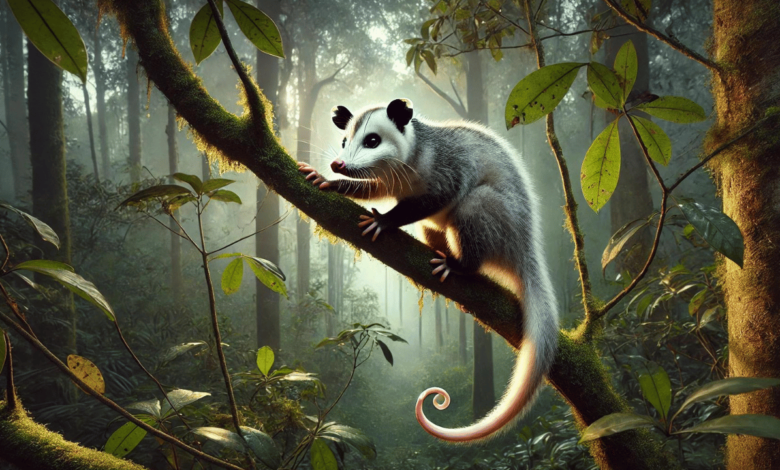Tñacuache: The Iconic Marsupial of the Americas

When we think of wildlife in the Americas, a few iconic species come to mind—jaguars, condors, and monkeys. However, one lesser-known but equally fascinating animal is the tñacuache. Often overshadowed by more exotic animals, the tñacuache (sometimes spelt tlacuache) is a marsupial native to the Americas that deserves its place in the spotlight. In this article, we will explore everything there is to know about this intriguing creature, from its biological traits to its role in cultural folklore.
What is a Tñacuache?
The word tñacuache is primarily used in Mexican Spanish to describe the opossum, a marsupial found throughout the Americas. More scientifically, this animal is known as Didelphis virginiana or the Virginia opossum, the most widespread species of opossum. While the term tñacuache is commonly used in Mexico, it might vary regionally, with different dialects adopting the name slightly.
The tñacuache belongs to the family Didelphidae and is most easily recognized by its greyish fur, pointed face, and prehensile tail, which allows it to grasp objects. Unlike other mammals, the tñacuache is a marsupial, carrying its young in a pouch like kangaroos or koalas.
Physical Characteristics of the Tñacuache
Several distinct features often characterize the tñacuache:
- Size: Most tñacuaches are medium-sized, with adult opossums measuring around 35 to 50 centimetres in body length, not including the tail. The tail itself can add 25 to 40 centimeters.
- Tail: Their tail is prehensile, which functions like a fifth limb. This is particularly useful for climbing trees or holding onto objects.
- Fur: Their coarse fur is usually grey or white, although variations depend on the species and environment. Their underbelly tends to be lighter than their upper body.
- Ears and Eyes: They have dark, beady eyes and large, hairless ears. Their night vision is excellent, as they are primarily nocturnal animals.
- Teeth: Tñacuaches have sharp teeth and can be aggressive when cornered, although they typically avoid confrontations by playing dead—a behaviour known as thanatosis.
Habitat and Distribution
The tñacuache is highly adaptable and can live in a variety of habitats. From dense forests to suburban neighbourhoods, these creatures thrive in various environments:
- Range: Tñacuaches can be found throughout North and Central America, from southern Canada to northern Argentina. They are ubiquitous in Mexico, where the species has adapted to rural, urban, and suburban areas.
- Climate: These animals are resilient and can tolerate hot and cold environments, although they prefer temperate climates with abundant food resources.
- Shelter: In the wild, tñacuaches often create dens in hollow trees or abandoned animal burrows. They may find shelter in attics, garages, or under decks in urban environments.
Diet and Behavior
Tñacuaches are omnivores, which means they have a varied diet. Their adaptability in terms of food allows them to thrive in diverse environments. Here’s what a typical diet for a tñacuache looks like:
- Insects: Beetles, grasshoppers, and crickets are some of their favourite snacks.
- Small Animals: Tñacuaches will eat small rodents, birds, and even other reptiles if given the opportunity.
- Fruits and Vegetables: They have a taste for fruits like bananas, apples, and berries. In more urban environments, they can be seen scavenging for food in gardens and trash cans.
- Carrion: Tñacuaches are also scavengers, meaning they eat dead animals. This behaviour helps clean up the environment, as it prevents the spread of disease by consuming decaying matter.
Tñacuache Reproduction and Lifecycle
One of the most fascinating aspects of the tñacuache is its reproductive cycle. As a marsupial, the tñacuache has a unique way of caring for its young:
- Breeding: Female tñacuaches typically breed twice a year, with the peak seasons being spring and fall.
- Gestation: The gestation period is remarkably short—about 12 to 14 days. After this brief period, the female gives birth to a very underdeveloped young, crawling into her pouch to continue growing.
- Pouch Development: Newborns remain in their mothers’ pouches for up to two months before emerging. After leaving the pouch, they still rely on their mothers for protection and food for a few more weeks.
- Independence: The young tñacuaches are ready to venture independently when they are three months old.
Role in Ecosystems
Despite often being seen as pests in urban areas, tñacuaches play an essential role in the ecosystem:
- Pest Control: As omnivores, tñacuaches help control insect populations and reduce the number of small rodents.
- Scavengers: By consuming carrion, they help reduce the spread of disease and keep environments clean.
- Seed Dispersers: Through fruit consumption, tñacuaches help disperse seeds and promote plant growth and biodiversity.
Tñacuache in Mexican Culture
The tñacuache is special in traditional folklore and indigenous myths in Mexico. One of the most famous tales is from the Mixtec people, where the tñacuache is credited with bringing fire to humans. According to the legend, the tñacuache stole fire from the gods and carried it in its tail, which is why the animal’s tail is considered hairless today.
This legend portrays the tñacuache as both clever and self-sacrificing, endearing it to many indigenous groups in Mexico. Today, the animal is often viewed as a symbol of survival and resilience due to its ability to thrive in rural and urban settings.
Threats and Conservation Status
Although the tñacuache is highly adaptable, it still faces several threats, particularly in urban environments:
- Habitat Destruction: As urban areas expand, the natural habitats of tñacuaches are shrinking, forcing them to live closer to humans, where they are often considered pests.
- Road Mortality: One of the biggest dangers for tñacuaches is cars. Because they are nocturnal animals, vehicles often hit them during their nightly scavenging trips.
- Persecution: In some areas, people kill tñacuaches, viewing them as nuisances due to their scavenging behaviours. However, these animals are crucial for ecosystem balance, and their decline could have negative environmental impacts.
Conclusion: Appreciating the Tñacuache
The tñacuache is an often misunderstood creature. Despite being labelled as pests in many areas, these marsupials are vital to the ecosystem, helping to control pests, clean up carrion, and disperse seeds. Mexican culture celebrates their cunning and resourcefulness, which have helped them survive and prosper in a changing world.
As we continue encroaching upon their natural habitats, it’s important to remember the vital role that tñacuaches play in maintaining ecological balance. Through conservation and education activities, we may guarantee that future generations will continue to learn about and appreciate these remarkable creatures.
FAQs About Tñacuache
Are tñacuaches dangerous to humans?
While tñacuaches may hiss and show their teeth when threatened, they are generally not hazardous to humans and prefer to avoid confrontation.
What do tñacuaches eat?
Tñacuaches are omnivores, feeding on fruits, insects, small animals, and carrion.
Can tñacuaches be domesticated?
While some may attempt to keep tñacuaches as pets, they are wild animals and do not adapt well to domestic life.
Why do tñacuaches play dead?
Tñacuaches play dead as a defence mechanism when they feel threatened by predators. This behaviour, known as thanatosis, helps them avoid attacks.
How can we help protect tñacuaches?
Protecting their habitats, reducing road mortality, and educating the public about their ecological importance are critical steps in conserving tñacuache populations.
You May Also Read: Kaydence Gartman Alaska: A Story of Resilience, Recovery, and Advocacy




